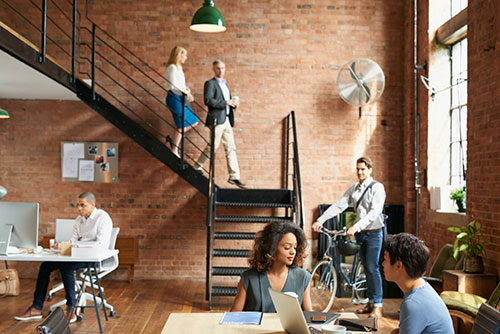
Imagine your typical office. What are you envisioning? Does your vision consist of rows of cubicles in front of offices with frosted glass walls and large wooden doors? Perhaps you are thinking of something with more of an open concept with lots of large tables for collaboration.
How ever you picture an office, chances are someone else envisions something completely different due to the many variations out there today. However, the question of efficiency and output still remains. How does a company go about designing their office environment to maximize their business productivity, entice and retain talented individuals, and accommodate clients?
Classic Offices
Many still believe that a traditional office design consisting of individual, enclosed offices and conference rooms is the best way to create a professional, distraction free environment. Collaborative work can be accomplished in one office, while other tasks are carried out by individuals in cubicles or separate office spaces. However, there are those who would argue that this type of office design can discourage and even hinder inter-office communication and interaction, thereby decreasing day-to-day productivity.
Contemporary Open Concept
Those who dislike traditional, enclosed office layouts may favor more open concept designs with large, centrally located tables and open work spaces to better facilitate collaboration and communication. Open concept work environments may be viewed as more welcoming and therefore more encouraging of participation and discussion, although noise and other distractions can make this type of layout unsustainable.
The Third Space
An emerging concept in open concept office design is the “Third Space.” The third space refers to an office area that is neither a designated office or a conference room. Instead, this space is meant to be a nonrestrictive workspace where employees can get a change of scenery while still getting their work done. Some have compared this concept to the business lounges often found at airline terminals, while others have likened it more to a calming and meditative space that feels less confining than an isolated work station.
Finding the Balance
Others have experimented with office layouts that combine the best aspects of both open and closed office design theories. In fact, several internationally well-known companies utilize these blended office environments to increase both the creativity and productivity of their employees. Large corporations like Google mix aspects of both traditional and contemporary office design in many of their international offices. Where cubicles are utilized in the design, the walls are kept low to mimic an open concept environment while still providing individual work spaces. Enclosed, quiet spaces in Google’s hybrid offices can range from simple, partially walled-off pods with benches around a central table all the way to the truly whimsical camper trailer work space in their Amsterdam offices! It's partially thanks to such forward-thinking office design that Google has been named the best place to work six years running! Other companies such as AirBnB and Facebook also blend traditional work space layouts with creative and unique open concept areas. These companies are embracing such inviting and versatile working environments as a way to entice and retain employees. They understand that employee happiness can lead to an increased productivity, so they work to ensure that their offices suit a wide variety of working styles.
Combining Work and Play
There’s more to employee morale than a good office layout. Most people spend about a third of their day or longer at work, so some companies have found that offering amenities as a part of the office environment can also help to attract new talent and increase employee happiness and productivity. Cafeterias and nice kitchen areas keep employees and clients from darting off at lunch time, and can potentially help facilitate impromptu lunch meetings or even after-hours work sessions built around a fun dinner. Some offices even offer gyms or exercise rooms to help keep their staff happy and healthy. While not every office needs a rock wall or skateboard ramp (both of which Google offices proudly offer), some distractions can help bolster creativity, productivity, and the overall mood of their employees.
When building the perfect office design there are many architectural and developing options to choose from, visit PinPoint Commercial online for information about commercial office space.


